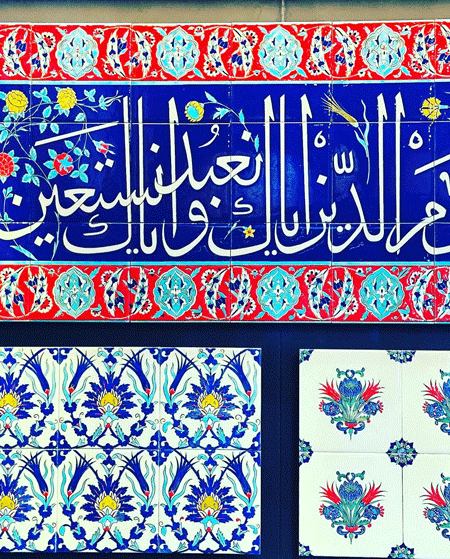September 1-13, 2023

Here we are back in Turkey. Istanbul specifically. I’d like to think of this as a continuation of our Turkey trip from last fall, because, well, it is. As a refresher, we were enjoying amazing Cappadocia, Turkey, when we had an urgent matter back home- so home we went.
So now we’re back to visit Istanbul, the one Turkish city we missed out on…and it feels like we never left.
Hagia Sophia Mosque
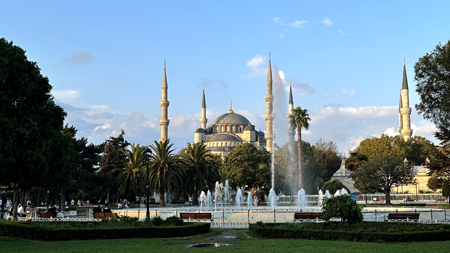
Don’t Get Cocky
We arrived at the Hagia Sophia, a “must-see” in Istanbul, early on a Monday morning. The Grand Mosque, built in 537 AD, features innovative architecture, rich history, and tons of religious significance. It became a UNESCO World Heritage site in 1985.
The Hagia Sophia is definitely one of the tourist heavy-hitters, and we mapped out our visitation strategy early on. Determined to avoid the crowds we’d seen all weekend, standing in massive lines that wound round and round and clear out of the expansive Sultanahmet square, we planned on visiting on an early weekday morning.

Monday Morning
We were happy to arrive fresh on our first Monday morning after our complimentary Turkish breakfast buffet at the hotel. We found ourselves in line with some fellow Americans who were from San Francisco. They were on a 24 hour layover on their way to Italy.
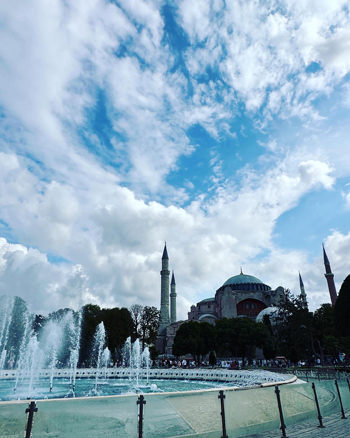
We chatted with the young couple, who were traveling with her parents and brother. We were giving them lots of helpful tips to make the most of their day, drawing on our travels from last fall. It felt great to be so helpful to our fellow west-coasters.
At one point, the woman’s mom turned to me and asked one, and only one, question, “Do I need a headscarft to get into the Hagia Sophia”?
“Nooooo”, I said. “I’ve visited many mosques all over Turkey. As long as your knees and shoulders are covered, you’re good.” She was relieved, since she didn’t have a headscarf with her.
And We’re In
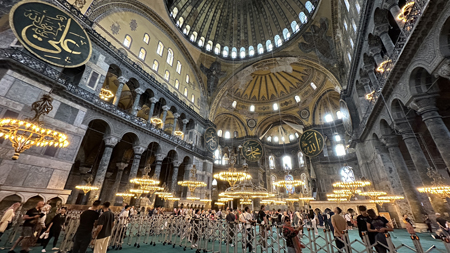
At 9:00 am sharp the line started moving. The mosque holds up to 20,000 worshipers, so a good chunk of the line was allowed in during the first round, including us.
All visitors are required to go through a security check, then pass by staff who make sure all woman meet mosque standards. I confidently walked through and was immediately flagged.
There was a flurry of Turkish coming from multiple staff who were approaching me, making sure I stopped in my tracks, while one staffer pointed at my head.
Dang, you’ve got to be kidding. I’m wearing pants. I’m wearing a shirt that covers my shoulders and part of my arms. There can’t be a problem with my head, can there?
With my uncovered head hanging low, I slowly made my way towards the window on my left where they sell horrible paper blue scarves for those lame enough to not have a scarf of their own. But right then the staff enforcer noticed Steve holding his University of Washington Huskies baseball cap and said I could wear it as my head-covering. So I did.
So there I was, in the famed Hagia Sophia, a revered, ancient, religious and historic icon of a building, in my bright purple Huskies cap with a giant gold gold embroidered “W”.

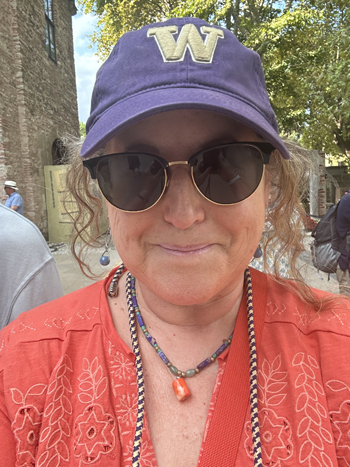
I stood out like a sore thumb, looked like an infidel, and was surrounded by literally thousands of women in headscarves. Yeah, not my best moment.
My apologies to the San Francisco visitors who I assume ended up with the lame blue paper scarves.


The Tramvay
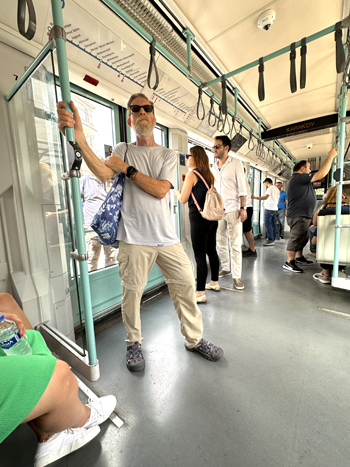
We consulted our trusted Rick Steves guidebook on how to purchase tramvay (tram) tickets. Following Rick Steves’ instructions, we purchased two tramvay cards from a newspaper kiosk for 100 lira per card (or $4 USD). Rides are only about 50 cents, so that seemed like plenty of credit to last us a while.
Easy Enough
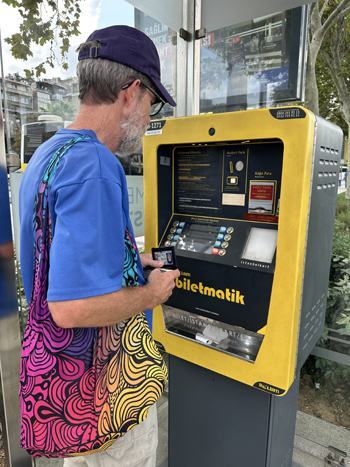
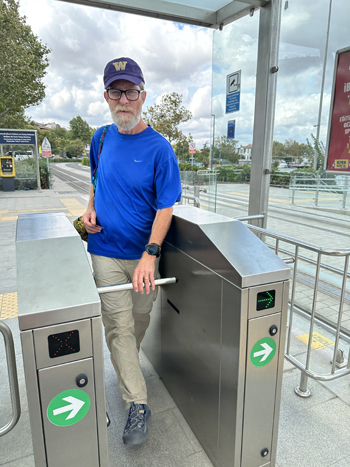
Red tram cards in hand, we walked up to the busy and crowded tram turnstyle and laid our tramvay card on the reader, as we had seen others ahead of us do.
Here’s the sequence: the card is read, a green light goes on, you hear a pleasant ding, and the turnstyle lets you through. But that’s not what happened.
Our card lay on the reader, but we didn’t get a pleasant ding or a green light. Instead the reader had a lengthy message in bright red. The message obviously contained the secret to our error, but did us little good, since we don’t read Turkish. All we knew is that things were looking bad. Very bad.
We tried again, and again, and again, hoping that if we turned our card this way and that, or perhaps flipped it over, the dreaded red message would clear. I turned to take a quick look at the folks behind us, desperately hoping that someone would see the look on my face (bewilderment, embarrassment, panic?), take pity, and help us. Alas, all I saw was a sea of impatient faces glaring back at us.
After a couple of minutes that seemed to last an hour, we gave up all hope that our card would magically start working. Unsure of our next move, we walked over to the bank of tram machines that lined the sidewalk just outside the tram entrance. Per Rick Steves’ guidebook, the machines are used to re-load the tramvay cards when the lira (credit) has been used up.
Teen Tourist Helpers: To the Rescue
It was a busy Saturday, and there was a large cluster of people jammed up trying to get to the machines. Not much of a line, more of a free-for-all, push your way in situation. Then we noticed two young people, teens in fact, wearing bright yellow t-shirts with “TOURIST HELPER” emblazoned across the back. Thank God.
As you can imagine, these two teens were in high demand, since half the people in line were tourists. Eventually we made it up to the front where we could talk to our saviors, the Turkish teens in yellow t-shirts.
“Where did you get this tram card?” the petite teen girl confidently asked Steve. She was obviously used to working with novice tramvay folks that are out of their element.
“From the man at the newsstand”, Steve answered, pointing towards the nearby newsstand. “It’s loaded with 100 lira (equivalent of $4)”.
“Ohhhh, you should never buy your tram card from some man on the street”, she said. Well, that’s not exactly what Steve had said. We didn’t buy our card from some man on the street, but let’s not contradict our helper.
Bad News
She set the card on the reader. “This tram card has no money loaded on it”, she informed us, with a look of pity. “You should only buy your card here at the machine. It is much safer”. Hmmm…thanks Rick Steves (guide book author).
The teen quickly proceeded to load our card with the 60 lira Steve handed her. She pressed several buttons in quick succession and voila, we were loaded and ready. The turnstyle was happy and gave us a quick, pleasant ding, along with the coveted green light. The turnstyle gave way easily and we were on our way.
The Neighborhoods
Istanbul is a city of 15.46 million people. Istanbul has been categorized into 39 regions with an estimated 936 neighborhoods. We were lucky enough to stay in two of those neighborhoods and visited quite a few more.
Sultanahmet

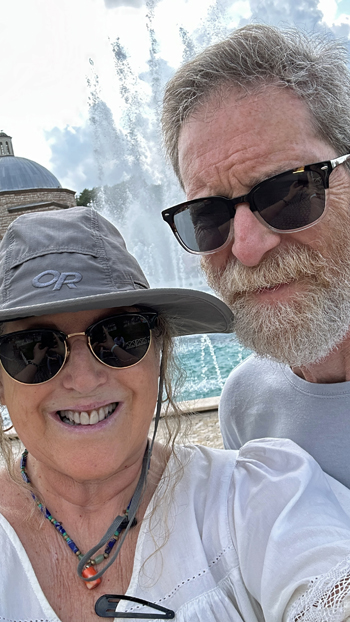
We spent our first eight nights in the old Sultanahmet area, where most tourists stay their first time in Istanbul. Even though it was quite touristy, I’m glad we did, since it’s so central to many “must-see” sites.
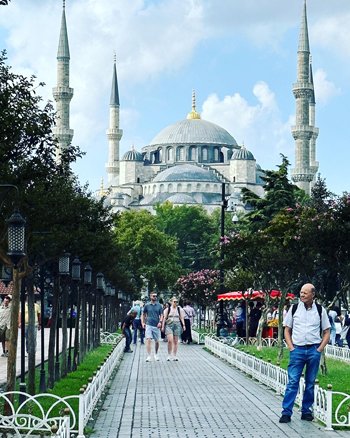
It actually has a bit of a Disneyland feel with the beautiful gardens and fountain framing the magnificent mosques on either side of Sultanahmet Square. It’s surreal.
It’s an area brimming with outstanding sites and historical significance. Everything is close by. It’s also a bit chaotic with so many people & activity, tour buses and tour groups, restaurant owners trying to get you into their restaurants, and carpet salesmen trying to make friends with you.
Galata Tower
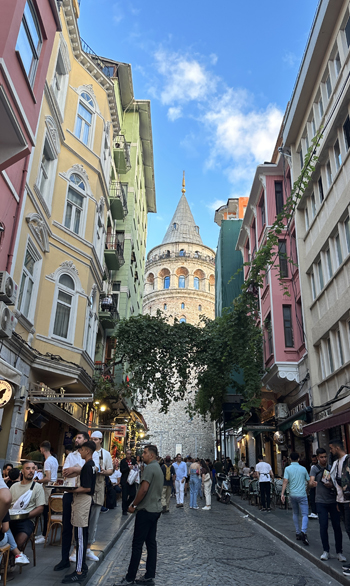
Our last four nights were spent at a small hotel a moment’s walk from the Galata Tower, one of the iconic symbols of Istanbul. The tower dates back to 527 AD, and was used as a watchtower through the ages.
Steve went up the Galata Tower and got some beautiful shots. An elevator took him up six floors, then he had to climb 70 stairs up the rest of the way to the lookout on top. There’s no elevator allowed on the way down, so it’s a long 9 floors! I was busy doing something or I’m sure I would have come along.

Like Sultanahmet, the Galata area can be quite touristy. The Galata Tower and the main arterials leading to the tower are almost always mobbed with tourists. But once you get off the main street, the feel is very different than in Sultanahmet.
There’s an actual grocery store (Migros), an electronics store, and other “regular” stores for locals around. It was nice to see more of a working neighborhood. There’s some cool vintage and artsy shops. It’s a charming area.
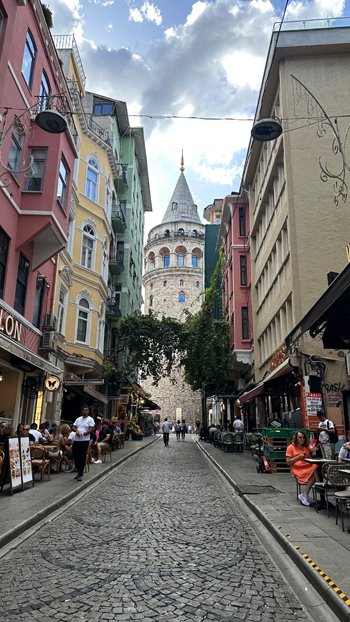
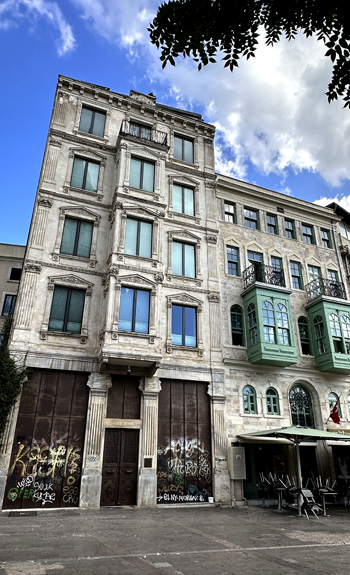
Old Wall Walk: Rick Steves
The walls of Constantinople rank amongst the most impressive city walls in the world. Istanbul originated on a peninsula flanked by the Golden Horn and the Bosphorous; in part because it was so easy to fortify, hence the Walls.
With Rick Steves’ book in hand, we made our way through very authentic neighborhoods with not a tourist in sight (except us).
Tekfur Palace (Museum)
A black cat became enamored with Steve while we walked through the Tekfur Palace Museum along our route.
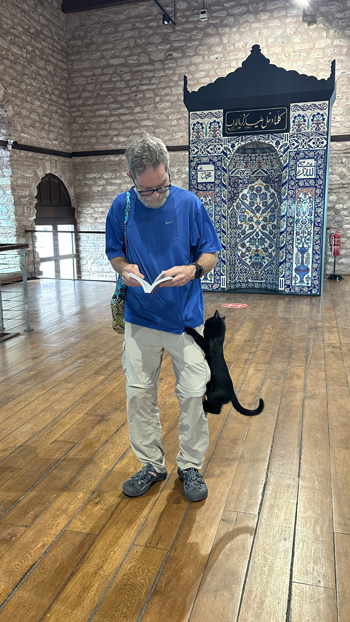
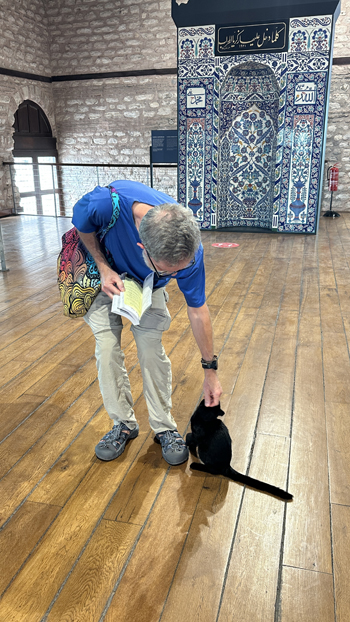
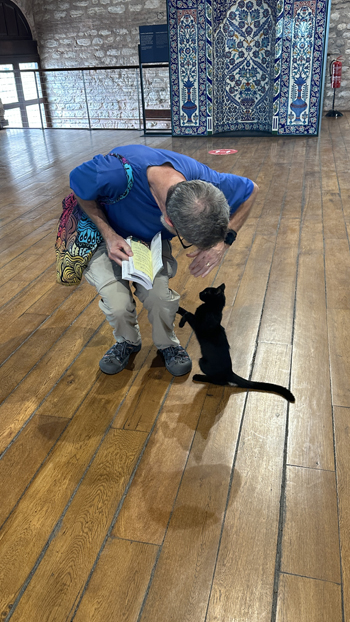
Continuing On
We visited historic gates, mosques, churches, and universities. We passed through the Lonka neighborhood, and finally ended in an up and coming, trendy neighborhood of Balat.


Manti, Yum
Last year we discovered Manti, a tortellini-like dish with thick greek yogurt and chili sauce drizzled on top, and it quickly became a favorite of mine. We’ve tried Manti at a few other restaurants in Istanbul, but it’s never measured up.
Until Balat and Mitis Manti ve Cafe. What a gem. The best mushroom manti of my life.
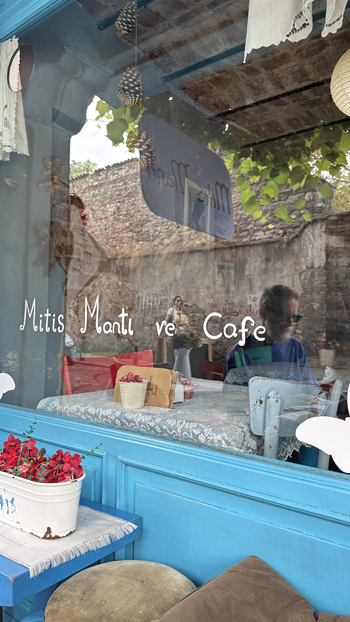
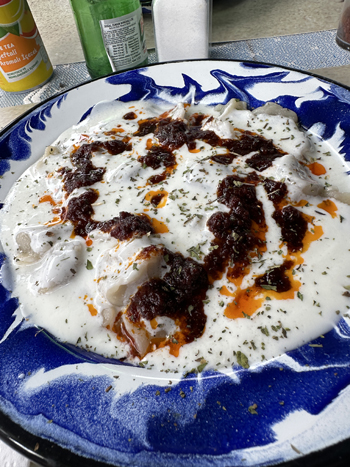
The Carpet Salesmen
Walking through Sultanahmet Square is lovely, except for one thing, the carpet salesman. In our experience they are always men, and their opening line is eerily similar.
“Where are you from?”
“Where are you going? I can help you. I’m not a guide.”
“I am not trying to sell you anything, I just like to practice my English.”
“You are a beautiful couple. Are you on your honeymoon?” (really dude?)
“Would you like some tea?” “Do you want a carpet?”
It doesn’t sound so bad, but these men are relentless. It’s impossible to walk 20 feet without one of them trying to reel you in.
Knowing how friendly the Turks are, I do believe these guys are sincere and want to chat. They seem to enjoy saying hello and getting to know you. The problem is, they also really, really, really want to sell you a Turkish carpet. And those carpets aren’t cheap.
These guys are often quite charming and even offer help (to the fledgling tourist). It can be tempting to engage with them.
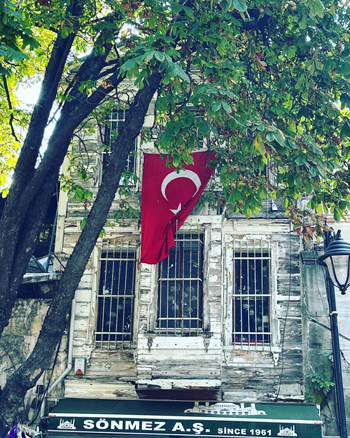
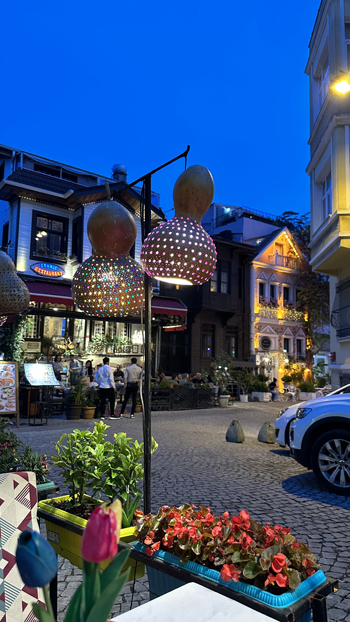
Suckered In
The problem is, before you know it, you’re drinking tea in the basement of a carpet salesman’s store. And yes, that’s exactly what happened to us our first morning. It only delayed us about 20 to 30 minutes and we did get to sit in the glorious air conditioning for that time, but it was very uncomfortable (and almost painful) extracting ourselves from that store without making a purchase.
And dang, that one deep red and black carpet sure was beautiful…hahaha. I told you, these guys are good!
Here are our basic rules for walking through the Sultanahmet neighborhood without getting stopped 14 times in 30 minutes, which we engaged after our first morning:
- Keep moving and do not make eye contact.
- Do not, I repeat, do not, under any circumstances, answer any question thrown your way.
- Even though it may seem rude, the only responses you may give are: “We’re good” and “No thank you”. That’s it. Your only choices.
- If you answer their question, or say anything else, they’ve engaged you, which is their number one goal.
The Target Demographic
I later learned, to my great surprise, that our experience with the carpet salesman isn’t universal. We met Kevin, a twenty-something masters student from the USA, while having dinner one night. He had just finished his first day in Istanbul, and told us he had not been approached even once by a carpet salesman! So apparently a young, single man just isn’t the demographic the carpet salesman are targeting.
But an older white couple is. Believe me.
The Blue Mosque
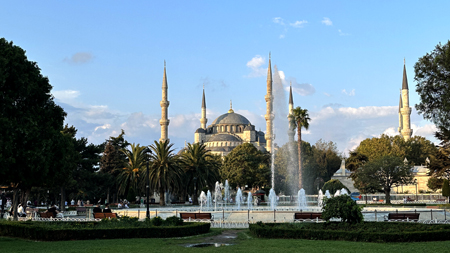
Right across the massive Sultanahmet Square from Hagia Sophia stands The Sultan Ahmed Mosque, commonly called “The Blue Mosque”.
Building started in 1609 for this masterpiece, commissioned by the Sultan Ahmed I, who ascended to throne at the age of 14 as the 14th Sultan of Ottomans.

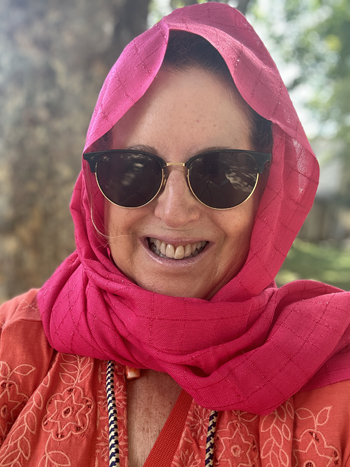
I expected to walk into a sea of blues, but that’s not what happened. Instead, I saw a magnificent and expansive interior with many colors. And that’s ok. It turns out that it was Westerners that named it the “Blue Mosque” for it’s blue tiles that have now faded with time.
Thankfully we passed a vendor selling scarves right by the Blue Mosque entrance. Imagine that? So I was now appropriately dressed for mosque gazing.
Whatever colors we found, the Blue Mosque was amazing.
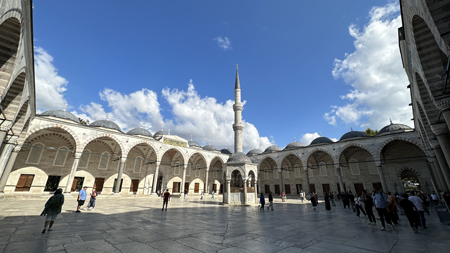
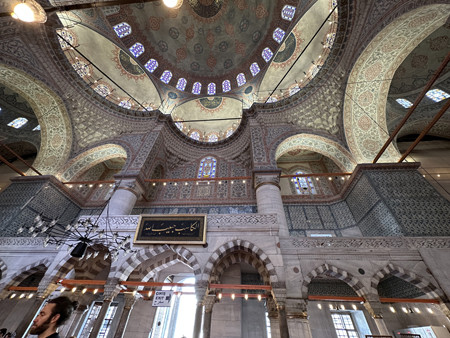
Whirling Dervishes
Who hasn’t heard of the Whirling Dervishes? Well, I certainly had, but honestly, I had no idea of their purpose, depth of conviction, or why the heck they whirl. So, we made a point of attending an amazing exhibition ceremony to see the Whirling Dervishes while in Sultanahmet, Istanbul.
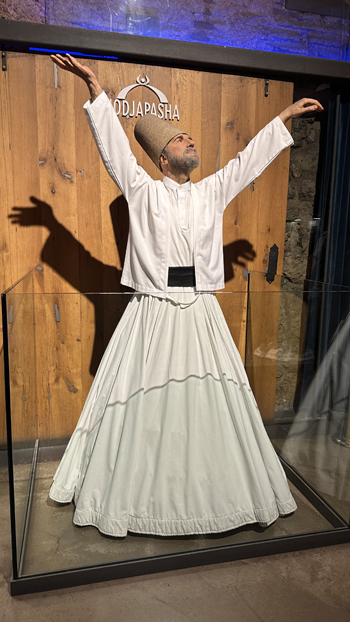
Whirling dervish ceremonies, were started by Jalaluddin Rumi, the famous Sufi Muslim mystic and poet, in the 13th century. The ceremonies are a form of meditation and a journey towards unity with God.
There are many parts to the ceremony, including bowing, salutes, chanting, and, of course, whirling.
The men wear tall, flat hats and large white circular skirts that fan out and gently rise to knee level as they whirl and whirl, all in the same direction and in unison. They lift their arms up over their head, the right hand facing upward, and the left hand facing downward, symbolizing “From God we receive, to humanity we give”.
What a privilege to experience their religious devotion and mesmerizing whirling. It’s incredible that they don’t get dizzy. In their typical practice they whirl for hours at a time.
The carefully choreographed movements, the skill and grace of their whirling reminded me of a beautiful ballet. It was so calming and simply beautiful. The lead dervish, who seemed to set the pace, would start and stop the whirling in a beautiful flow of movement, like an orchestra conductor.
Bosphorous Sunset Cruise
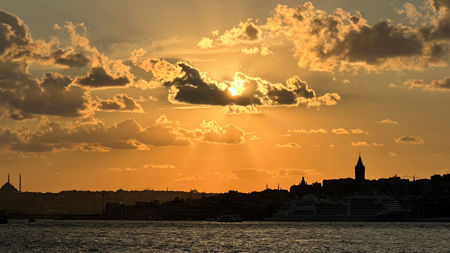
Our Bosphorous sunset cruise started across the Golden Horn (major inlet off the Bosphorous strait) in the “modern” part of Istanbul, quite a ways from where we were staying in Sultanahmet.
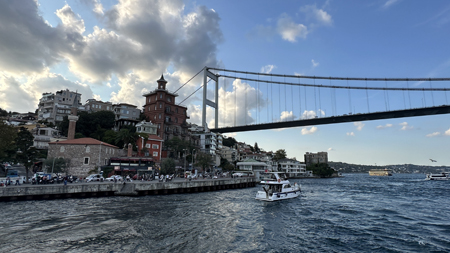
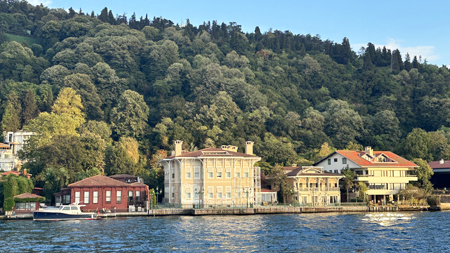
We cruised by lavish multi-million dollar mansions, beautiful parks and mosques, multiple amazing wedding venues (with weddings in progress), and many historic sites.
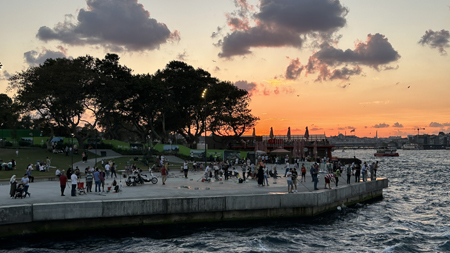
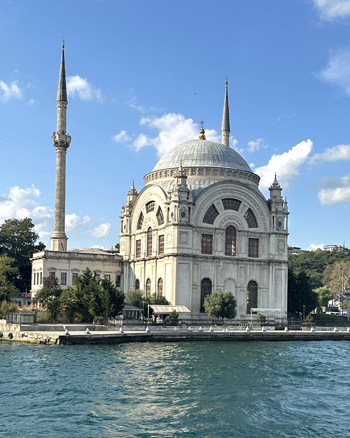
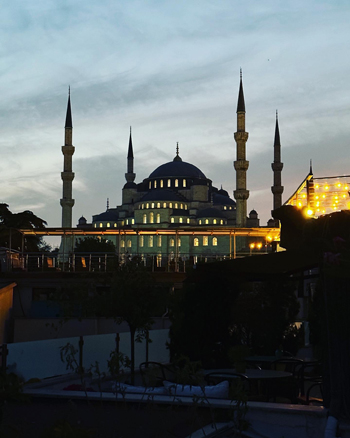
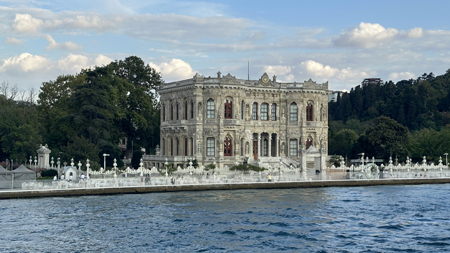

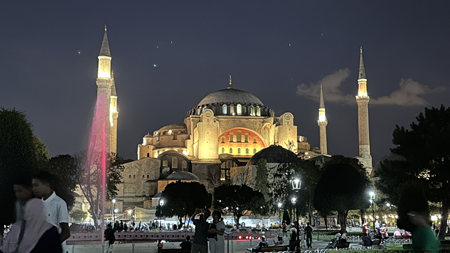
The Asian Continent
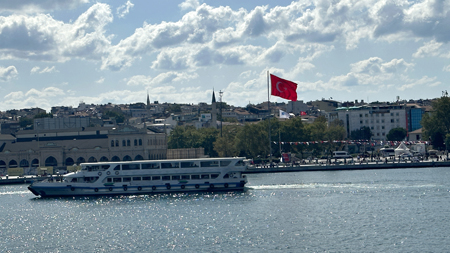
Istanbul straddles the Bosphorus Strait, lying in both Europe and Asia. We spent the entirety of our stay on the European side, so wanted to take a look at the Asian side.
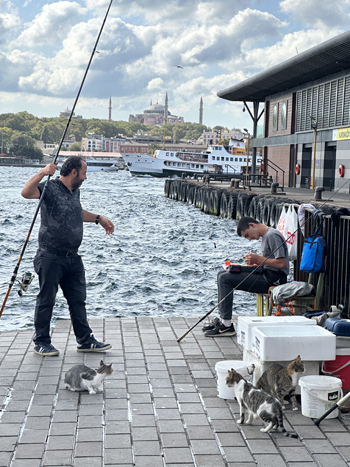
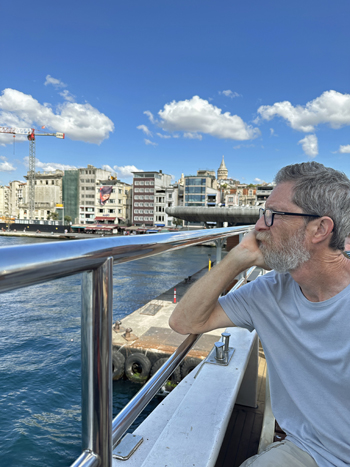
So, as nice as our Bosphorus yacht cruise was, when it came time to check out Kadakoy, an Istanbul neighborhood on the Asian continent, we opted to take a fifty-cent public ferry.

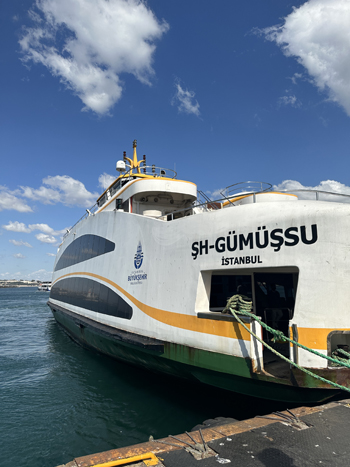
Once on the ferry, we made our way up two staircases and had first rate seats on the very top, in the sunshine and wind. It was a lovely thirty minute ride with gorgeous views.
Kadakoy was full of tourists, fish markets, restaurants, and a very popular Starbucks. It was also quite colorful!

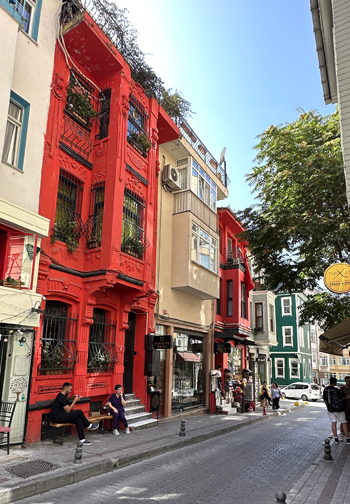
My Favs
The Süleymaniye Camii (Mosque), the Topkapi Palace, the Basilica Cistern, and the Dolmabahçe Palace were probably my favorite sites in Istanbul. Oh, and I’ll add in the Bosphorous sunset cruise too (see above).
Most of these sites do not allow photography inside, so please take my word for it that they were all absolutely amazing. All are highly recommended by me.
The Basilica Cistern
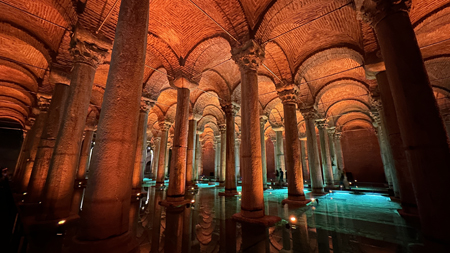
The Basilica Cistern is the largest of several hundred ancient cisterns that lie beneath the city of Istanbul. The columns, the reflection in the water, and the changing lights were simply breathtaking.
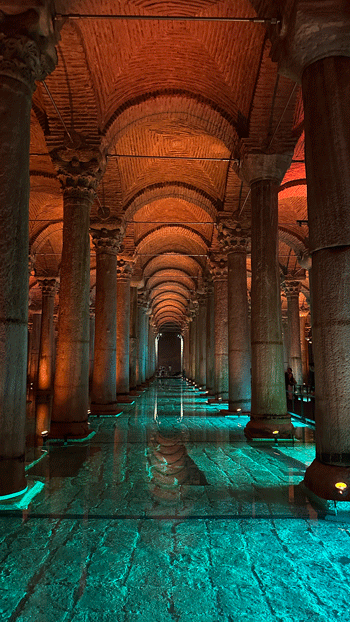
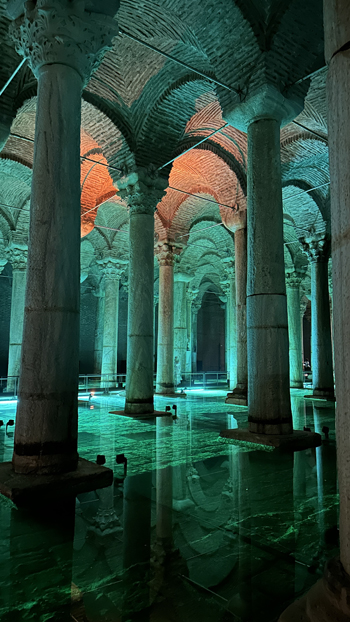
The Topkapi Palace, Old Home of Sultans
This lavish palace was the royal residence of the Ottoman empire for almost 400 years, from the 1460’s to 1856.
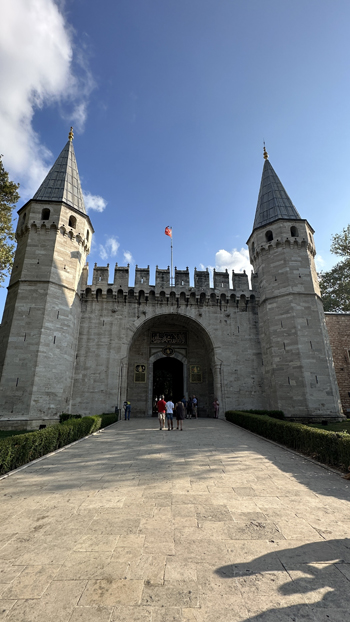

The Palace served as the administrative center of the Ottoman Empire, and was the main residence of the sultans and their families.
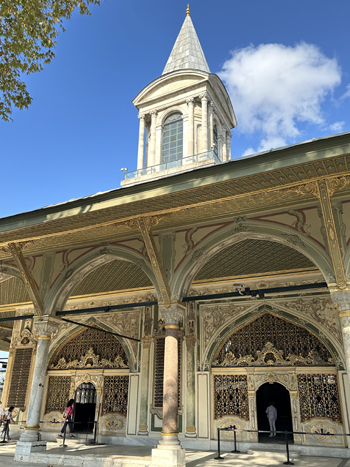

The tilework, the marble, and the gold throughout were absolutely beautiful.
Calligraphy was an artform. Every Sultan had his own calligraphy signature. Many were quite elaborate.

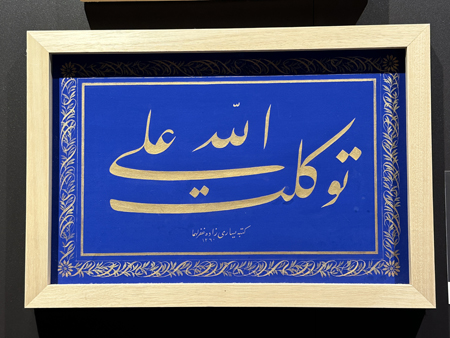


Süleymaniye Camii (Mosque)
Süleyman was the longest-reigning sultan of the Ottoman Empire (1520-1566). Süleyman the Magnificent commissioned the building of the mosque in 1550 as an Ottoman imperial mosque.
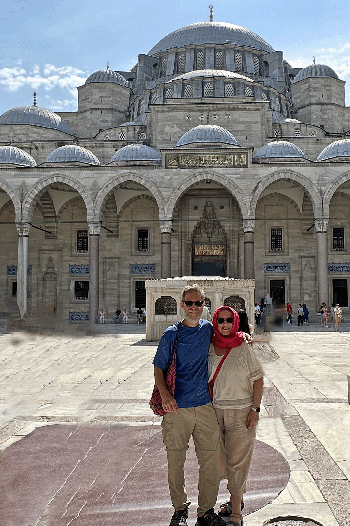
The truly staggering size of the Süleymaniye Camii is one of its most distinctive features. It was awe-inspiring (as were several other historic sites here in Istanbul).
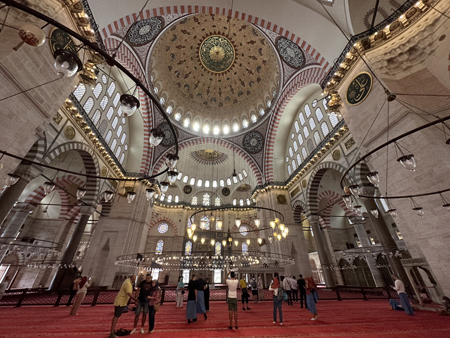
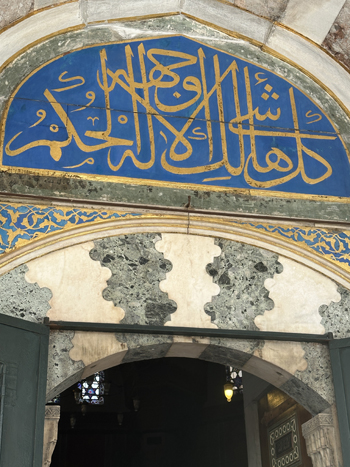

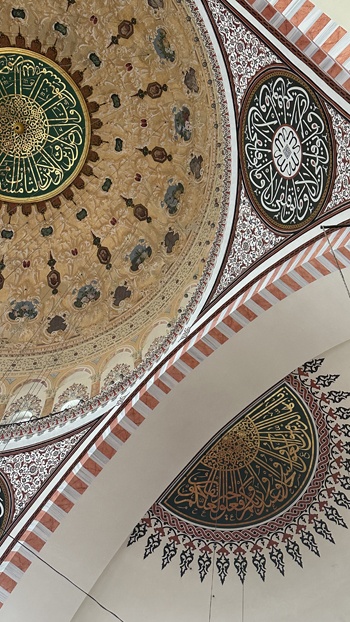


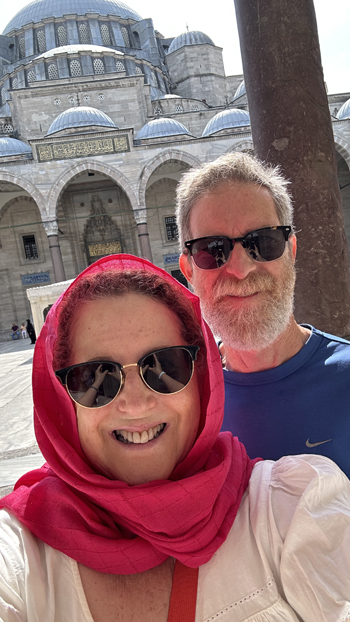

Dolmabahçe Palace, New Home of Sultans
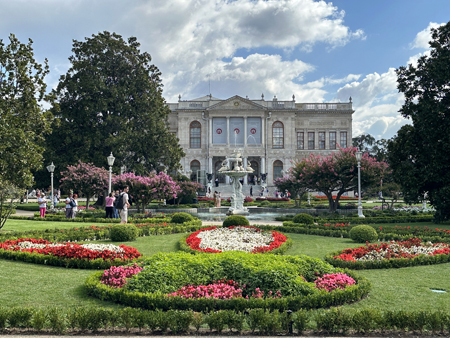
Dolmabahçe Palace, built in the year 1843, was the new residence of the Sultan Abdulmecid I.
The Sultan and his family had previously lived in the Topkapi Palace, but it was lacking in contemporary style, luxury, and comfort. He wanted a place that compared to the palaces of the European monarchs.
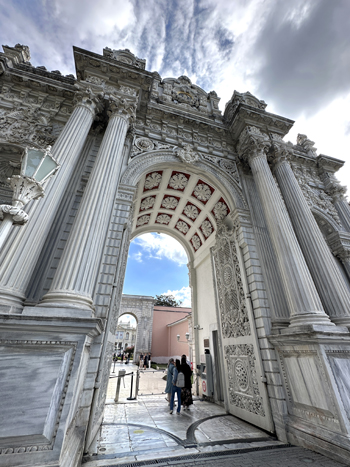
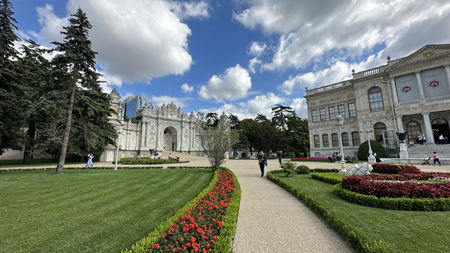
Dolmabahçe Palace Is the largest palace in Turkey. It covers eleven acres, and contains 285 rooms, 46 halls, 6 baths (hamam) and 68 toilets. No photography allowed inside, so only exterior shots here.
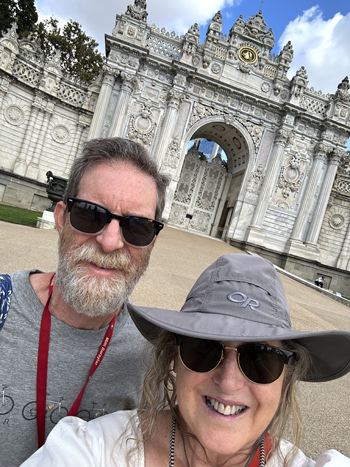
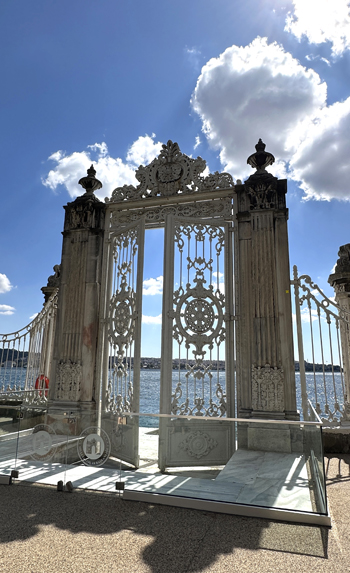
The Palace was over the top luxurious with jaw-dropping ornate ceilings, expansive rooms, unbelievably beautiful and colorful furnishings with silk upholstery, gigantic floor-to ceiling draperies, and enormous crystal chandeliers in every room – some with gorgeous colors.
Wins & Losses
Wins
Sweet (and large) stray dogs and cats everywhere. The Turkish take such good care of these animals. They all have their shots and get vet care. They are well respected and loved.
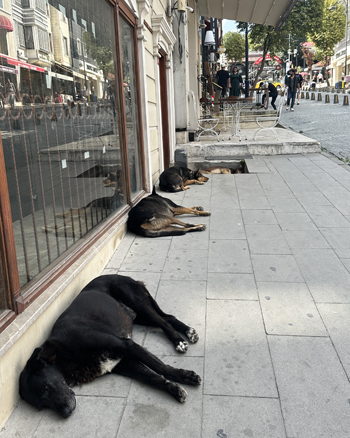

Steve’s beard is a big hit here among Turkish men. Even though very few Turks seem to have a beard, several men have gone out of their way to compliment his beard. They look, even stare, and study it carefully, and utter words of praise.

So when my backpack was flagged in Istanbul airport because of scissors, I explained the scissors were for trimming Steve’s beard. I mimicked the scissor motion and pretended to trim Steve’s beard. Snip, snip.
Once the security man knew the scissors were for Steve’s beard, he had an “ah-ha” moment and we were allowed to pass.
Losses
Major packing fail (on my part). I somehow didn’t pack my laptop charging cord, but thankfully Steve’s works for mine too. I also didn’t pack my little travel mouse, which makes this blog work much more tolerable!
We love Turkey, but did notice a huge difference between our experience last fall and this fall as to the friendliness of the Turkish people. We chalk it up to the fact that Istanbul is a mammoth city with a big city vibe, vs. the mid-sized cities and small towns where we found such warmth everywhere we went.
Goodbye Istanbul
There’s so much to do in this enormous and mesmerizing city. Even staying 12 nights, we easily filled every day from top to bottom.
